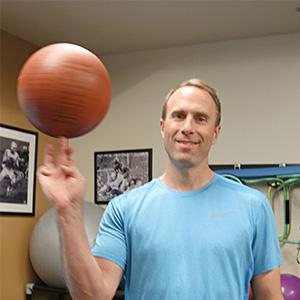Hans Bengtson

Dr. Hans Bengtson pivoted from surgeon to patient.
Hans was playing basketball on family vacation when his knee pivoted and instantly collapsed.
He knew immediately that he had torn his ACL, an essential ligament that stabilizes the knee joint.
“It was terrible,” he says. “It was extreme pain, just absurd.”
With his history of athletics and injuries, “I can sort of deal with pain, but this was so intense that it was clear something’s not right,” Hans says. He couldn’t straighten his knee, either. “Given my ortho background, I suspected I also had a meniscus tear,” injuring the cartilage that cushions and stabilizes the knee joint. An MRI study confirmed the damaged ACL and meniscus tissue.
Hans is an orthopedic surgeon; he has done hundreds of ACL reconstructions and meniscus repairs. "But doing my own surgery didn’t seem practical," Hans jokes. "I was now in the patient's chair."
For rehab after surgery, Hans chose physical therapist Kevin Johnson, PT in Rehabilitation Services’ Lakeville clinic. Kevin was Hans’ therapist back in high school, when a similar sports injury to Hans’ other knee required surgery and rehab. “I was stuck in a knee immobilizer for 6 weeks with that old injury, so I was really weak and stiff. I needed a lot of rehab to overcome that, as a teenager,” Hans recalls.
“I appreciate how Kevin handles things,” Hans says. “Our styles match up.”
This time, Hans’ PT started with soft tissue work, including massage and cupping – a warm cup suctioned to the skin to draw fluid out of the tissue and reduce swelling. “The soft tissue work made me feel better, and also improved my motion and allowed me to engage my quad more effectively,” Hans explains. “There was a lot of work in the early going where I valued the therapist’s understanding and techniques.”
When his schedule kept him in Northfield, Hans also worked with Joel Beithon, PT in Rehab Services’ Northfield clinic. “The two rehab clinics coordinate with each other, so there’s continuity of care even if you’re seeing a different therapist,” Hans explains.
“Our therapists at NH+C do a great job accommodating people’s situations,” he adds. “Whether that’s timing for appointments, or specific expertise – such as a PT who works more with ACL injuries and rotator cuff tears, back care, balance or lymphedema work, or pediatric care. All these areas of expertise have great value, depending on what the patient needs.”
Hans views therapists as teachers: “They teach patients what to do, how to do it, how to do it safely, how to avoid aggravating your injury. Once they teach you what to do, I hope patients feel confidence in being able to do a lot of it independently. But there’s great value in checking in intermittently with the therapist, like ‘Am I still doing this correctly? What’s the next stage I can do? I need something more challenging.’”
An ACL tear requires about nine-plus months for full recovery. At five months, Hans was able to walk well, do stairs, get in and out of the car, and stand for prolonged periods – watching a basketball game from the sidelines, for example.
Athletes approach physical therapy differently after an injury than other ortho patients do after a surgery, like joint replacement.
“There’s a little bit of the athletic competitive spirit: ‘I’ve got a goal, and I’m going to achieve it.’ And athletes are familiar with muscle soreness and pain, so you know when you’re in the moment and experiencing discomfort that it doesn’t always mean ‘stop’ – sometimes it might. But athletes tend to have a better sense of what pain is okay to push through, compared to not-okay pain, when you should stop.”
His advice for other athletes with an injury: “In the moment, RICE – rest, ice, compression, elevation. That’s always relevant that day, and overnight. Then depending on how things change over the next few days: If it’s not so bad the next day, you probably don’t need to be seen. But you should be seen if your motion is not right, if your pain is intense, if the injury area is notably swollen, or if you can’t do basic tasks like bearing weight while walking.
“It’s always helpful just to get a plan, too. It makes a difference to know what to expect. That helps build confidence and ease worry.”
And take the long view, Hans says: “It helps to have the big picture and see that you’re progressing. You feel like you’re working on it every day and it never seems to improve, but it does. Having a picture week by week instead of day by day really helps.”
Because even doctors need patience.
